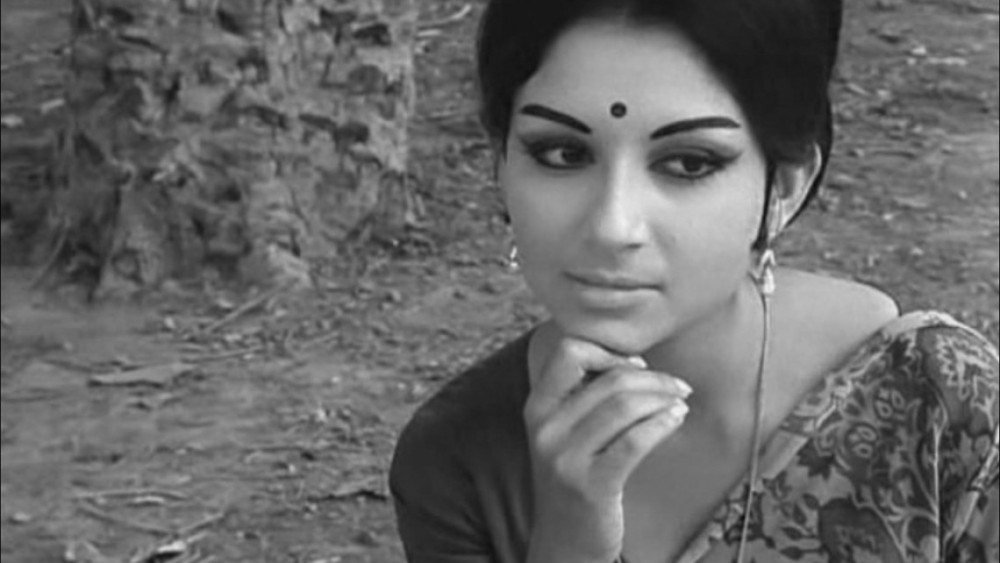BY Jhilam Gangopadhyay
Aranyer Din Ratri is an Indian Bengali adventure drama film that was released in 1970 and was written and directed by Satyajit Ray. It is based on the novel of the same name by Sunil Gangopadhyay. The movie is one of the earliest to employ the literary technique of carnivalesque. It has received critical acclaim worldwide and continues to be taught in film schools because of its technique, simplicity and craft of cinema.
Starring Soumitra Chatterjee (Asim), Subhendu Chatterjee (Sanjay), Shamit Bhanja (Hari), Rabi Ghosh (Shekhar), Kaberi Bose (Jaya), Aparna Sen (Hari’s ex-girlfriend), Sharmila Tagore (Aparna or Rini) and Simi Garewal (Dhuli), the film portrays the adventures of four friends from Kolkata who decide to take a vacation in the forests of Bihar to escape their hectic lives.
The film questions the integrity of the so-called Bengali ‘bhodroloks’ and depicts beautifully how easy it is for them to shed this label and the behaviour that comes along with it when given the opportunity. Bhadralok (literally ‘gentleman’, ‘well-mannered person’) is Bengali for the new class of ‘gentlefolk’ who arose during British colonial times (approximately 1757 to 1947) in Bengal. They mostly belong to the upper castes and classes. To be a bhadralok was to embrace some Western and Northern European values (though not always the same ones in each case), to have a modicum of education, and a sense of entitlement to (and consequently grievance against) favours or employment from the colonial government. While the bhadralok were influenced by the West (in terms of their morals, dress, and eating habits) they were also the people who reacted most strongly against the West, and the most scathing critiques as well as the most spirited defences of Westernisation were made by bhadralok writers.

It is depicted the movie that as far as these ‘bhadraloks’ are concerned, no matter what they do or how they act, they will always remain superior to the tribes and animals that inhabit the forest simply because they are from the city and ‘urban’ and ‘progressive’. The sense of class consciousness is evident from the beginning of the film.
The movie is as much about the three women whom the men encounter in the forest as it is about the men themselves. Aparna, the beautiful, educated and independent young woman who teaches Asim the value of humility, Jaya, her widowed sister-in-law, who gracefully hides her grief throughout the movie only to break down in the end and the Santhali lady Dhuli, who is constantly reprimanded because she doesn’t fit into the category of the ideal and ‘pure’ woman.

The movie starts with the four men travelling in a car, discussing their trip. Asim makes a comment about how when people leave Calcutta, there is a decrease in their age, thus foreshadowing their impending immature and ‘uncivilised’ behaviour which is justified simply because they are away from civilisation and in the midst of the forest.
On the way, Sanjay reads out an article about how both men and women drink alcohol among the Santhalis (the tribe which inhabits the forest they are visiting) shocking the rest of the group and creating a foreboding impression of all the other ‘shocks’ that the audience would be subjected to as the movie progresses. He receives constant comments by Shekhar, who is initially perceived to be the goofy and comical friend, but is actually the one who remains stable and unchanged throughout the trip, while the other seemingly sophisticated men lose their ‘bhodrolok’-ness amidst the forest.

Their first breach of rules is when they occupy the Conservator’s bungalow without any prior permission and bribe the chowkidar (security guard) to let them stay, inviting Shekhar’s comment, ‘Thank God for corruption’, signifying that it can happen to the best of us, no matter how morally superior we claim to be. Their second breach of norm occurs when they collectively decide not to shave, thus taking their first step to so called barbarism.
Then they burn a newspaper and Asim says, ‘Shobbhotar shonge shomosto somporko shesh’ (All relations with civilisation thus end here) and we only realize the significance of this later in the film. In the middle of the forest, they start screaming like ‘Tarzan’. Thus in subtle but powerful ways, Ray shows how these men slowly lose touch with their ‘civilised’ selves and touch the gateway to barbarism.
Soon they walk into a local bar where they spot women drinking and immediately begin to objectify them and their dark complexion, and the audience is quite shocked at the racist comments of these bhodroloks. Dhuli, a drunk tribal girl crawls to them and asks the ‘babus’ for ‘aadha pahua’ (a pint) of alcohol. The way Dhuli speaks, with her brimming sexuality and only one piece of cloth around her body, makes one uncomfortable, and one wonders how it was received by the audience of the 1970s.

The next day Shekhar sees two women walking, who are definitely not ‘Santhals’ because they are dressed ‘respectably’, in a saree and flats. And thus emerges the age-old debate: does the way a woman dresses and carries herself a deciding factor on whether she is to be respected or not? Shekhar asks around whether there are any ‘bhodroloker meye’ (daughters of bhodrolok) staying there and is pointed to their residence. They decide to visit and once they reach the bungalow, are invited inside by an old man. The older man, Sadashiv Tripathi, introduces his daughter Aparna, his daughter-in-law Jaya and grandson. Asim is immediately enchanted with the introverted and beautiful Aparna.
Asim informs his friends about the fact that Jaya is a widow and they discuss how difficult it is to make out widowhood these days. This comment comes from the patriarchal notion that once a woman has been widowed, she must give up all comforts of life and live in insolation and unhappiness. Jaya, on the other hand, seemed to be quite a happy-go-lucky woman who went to the extent of engaging in sports with the men, thus surprising them for her modern take on widowhood.
At the Tripathi’s household another morning, they ask Mr Tripathi if the animals scare him. And here is one of the important dialogues of the film, where he claims that animals don’t scare him, but men do. It makes us wonder that if given the opportunity, perhaps men can be more savage and barbaric than animals. Had the Tripathis not been there, perhaps the four friends would have indulged in so-called ‘unethical’ activities, without having to restrain themselves, as we see happens with Hari later in the film.
The movie perhaps came as a shock to the audience of the 1970s, who saw another side to the so-called ‘bhodroloks’ of upper middle class Bengali society. The various themes in the movie about the exploitation of the poor and societal expectations are clearly discernible through the brilliant direction and acting.
Personally, I am very impressed by Sharmila Tagore’s portrayal of the bold yet graceful Aparna who teaches women to take a stand for themselves and not be held down by societal expectations. Simi Garewal, who portrays Dhuli, shows us to what extent tribal women are exploited and by those very men who claim to be the most moral and ethical. So what if tribal women do not fit into the popular Indian description of a ‘good’ woman? Who is a good woman anyway? Everyone deserves a life of dignity, and that I believe to be strongest message sent out by this film, which is why I think it is essential for everyone to watch this film and understand that even today, after almost fifty years of release of this film, things have not really changed much and the film still remains relevant.


